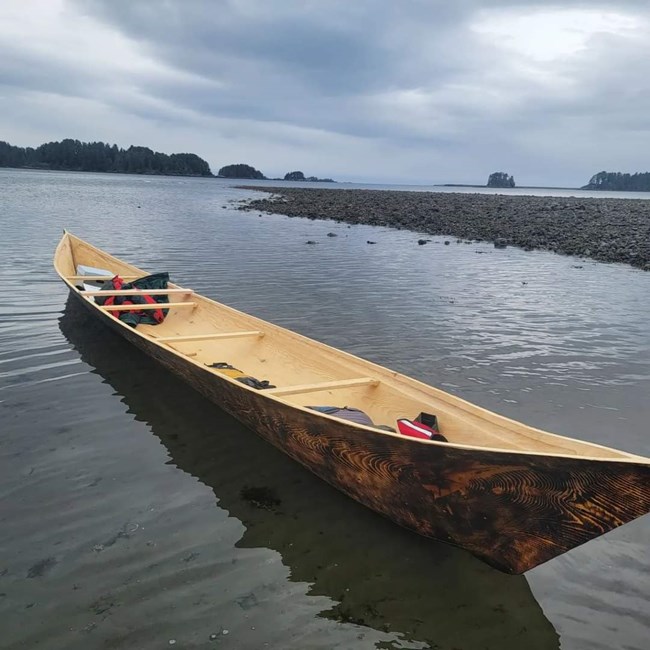Last updated: March 11, 2022
Article
New Canoe Takes its Maiden Voyage in Sitka Sound

Photo Credit/ Tim Flanery
All through the winter’s icy darkness
a warm light and steady thump, thump, thumping came from the carving shed behind the park visitor center, as Tommy Joseph (Naal’xák’w) and his apprentice, Tim Flanery (Gaanax aya yáada), worked to carve a traditional dugout “work” canoe out of a 25-foot Sitka spruce log.
Using traditional tools, Tommy and Tim transformed the log, which sat for seven years, into a functioning water vessel. The log itself came from the Gajook Héen Yik.áayi (Blue Lake) area of Sitka, which is a dammed reservoir used by Sitka for fresh water and hydroelectric power. Working with Sitka spruce, especially spruce that sat idle for so long, presented interesting challenges for the carvers. Rot was a constant issue as the carvers milled away the layers. The rot caused the carvers to reshape the canoe, at one point moving the center, to remove the rotted area. At other times all that was needed was to fill the rotted spots with an epoxy.
As the log was roughly shaped into the canoe form, large slabs of spruce were removed and set aside. From those slabs, paddles, and thwarts (seats/ braces) were carved. Since this was an opportunity for Tim to apprentice this process with Tommy, time was taken to learn to make each of these items as well as traditional adze handles from tree branches.
Once most of the carving was complete, the canoe was filled with water to ensure there were no leaks. Locally sourced volcanic rocks were heated and placed inside the flooded canoe, causing expansion which opened it up an additional 6 inches. Broadening the shape will eventually help to stabilize the craft when at sea. Splitting occurred during this process, and the carvers made small “butterflies” to place along the crack to hold the wood together, like stitches.
As a traditional work canoe, there will be no designs carved in or painted on. Ceremonial Tlingit canoes are often decorated with traditional formline designs, but work canoes are not. Instead, the carvers used a method called “pitching the canoe.” Using a propane torch, they charred the outside of the canoe. Charring tempers the wood, making it more waterproof. Traditionally during this process tree “pitch” (sticky sap) would be applied as an additional coating to waterproof. In this case, after the canoe was charred, a marine grade sealant was applied as a protectant.
Finally, as spring sunlight worked its way through temperamental clouds of Alaskan February skies,
the new canoe took its maiden voyage onto the waters of Sitka Sound. The timing was perfect, as this was Tim’s last full day in Sitka.
For Tim, seeing this project, his first canoe, from beginning to end brought immense sense of accomplishment. “I hope it’s not a ‘once in a lifetime’ experience” he said, “I hope to eventually have enough experience to be able to share it with future generations. Especially carving in spruce, since it’s like winning the lottery to get cedar.” Tim shared his thoughts on the potential of many benefits of easily accessible canoes for communities. “Canoes can be a tool for cultural and language immersion, subsistence harvesting, even drug and alcohol rehabilitation or prevention.” He also shared his hopes for this canoe, “I hope is gets to spend time on the water. It is a utilitarian creation- it wants to be used.”
Tim is already looking forward to his next apprenticeship opportunity. When he returns to his home he will be joining Nathan Jackson, a well-known carver in Ketchikan, to make a totem pole which will be displayed in Juneau. Staff at the park appreciate all of the work Tim has done and wish him a “Bon Voyage” and great joy in his future pursuits.
For Tommy, this was certainly not his first carving project, not even his first canoe, but all projects are a learning experience. Using an old Sitka spruce log presented many opportunities to problem solve. Working with an apprentice was also a learning process which Tommy enjoyed. “I’m looking forward to the next one” he said, “and I am looking forward to hearing from Tim as he works with Nathan in the near future.”
Once the summer sun shines down,
Sitka National Historical Park will put the canoe to work, using it to illustrate the timeless maritime history and seafaring ingenuity of native Northwest Coast cultures. Gunalchéesh (thank you) Tommy Joseph and Tim Flanery for your hard work on this canoe!
Visit our photo gallery to see photos of the progress of building this dugout canoe, from start to finish.

NPS Photo/Cinnamon Dockham
